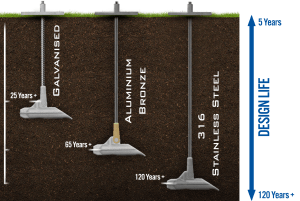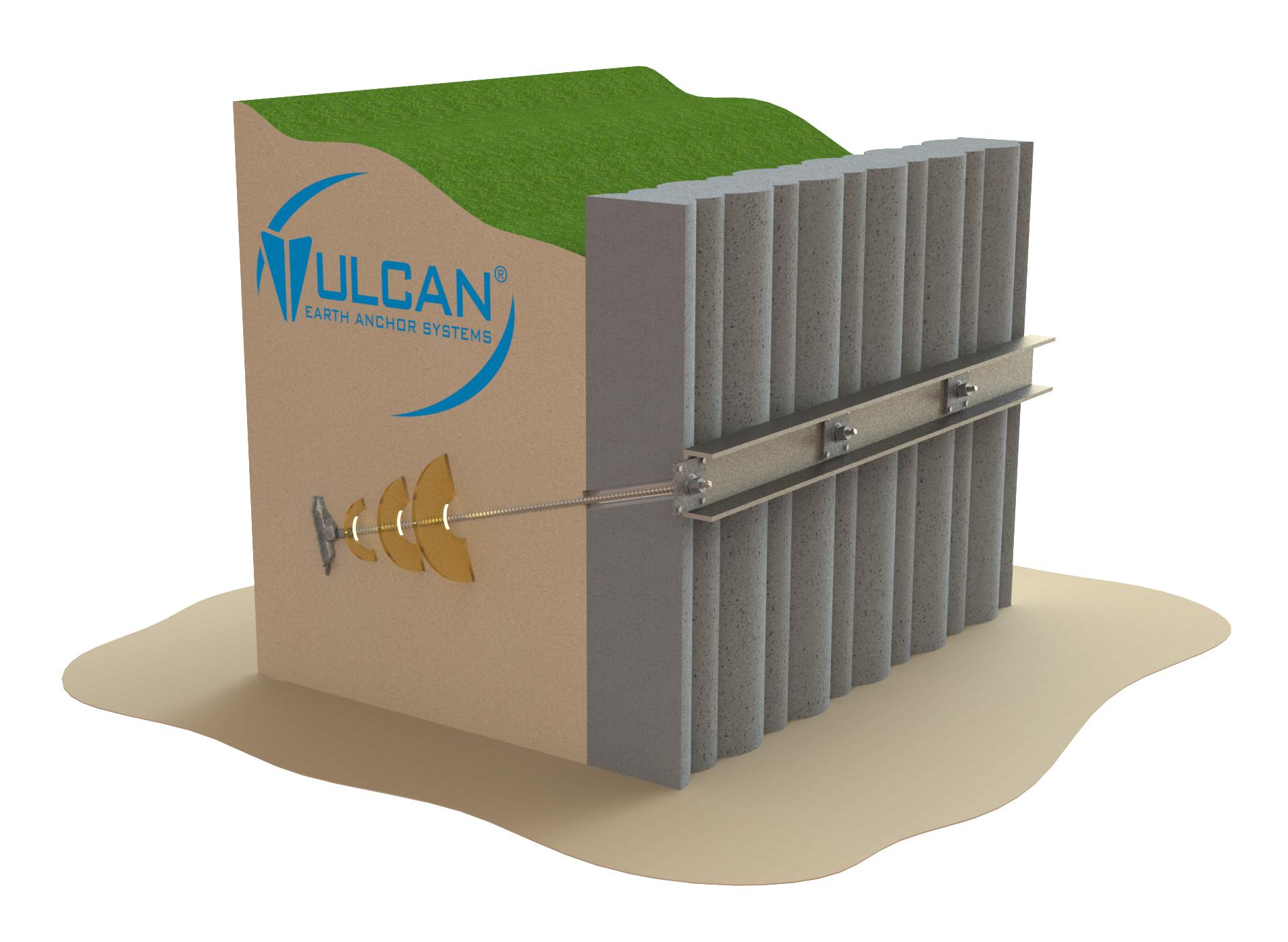Where Do You Install tensile load anchors for Optimal Performance?
How Sturdy Earth Anchors Job: A Comprehensive Overview to Soil Anchoring Solutions
Sturdy Earth supports play an important duty in giving security and assistance in numerous building applications. By embedding deeply right into the ground, they stand up to side and upright forces successfully. Different types of supports accommodate various dirt problems, making them functional. Comprehending their technicians and setup methods is important for optimizing efficiency. What aspects affect their effectiveness, and exactly how do they contrast to standard approaches? The responses might surprise you.
Understanding Heavy-Duty Earth Anchors
Sturdy Earth anchors work as crucial elements in various building and landscape design projects, supplying stability and assistance in tough soil conditions. These supports work by being installed into the ground, where they stand up to lateral and upright forces. Their layout allows for safe add-on to structures, guaranteeing they continue to be secured against dirt activity or outside loads.The efficiency of heavy-duty Earth supports mostly depends upon the kind of soil and the anchor's setup deepness. Appropriate setup strategies are vital, as they determine the support's holding capability. Environmental aspects, such as dampness and freeze-thaw cycles, can additionally impact performance.These anchors are often utilized in applications ranging from protecting fencings and maintaining wall surfaces to supporting temporary frameworks during negative weather. Recognizing the concepts behind heavy-duty Earth supports is vital for experts seeking to boost the toughness and safety of their projects.
Kinds Of Heavy-Duty Earth Anchors
Numerous kinds of heavy-duty Earth anchors are made to satisfy specific requirements based upon dirt conditions and task needs. Helical anchors, featuring screw-like blades, are effective in softer soils, providing high load abilities and easy installation. Driven supports, which are hammered into the ground, are suitable for rocky terrains and offer instant load assistance. Tie-back supports are commonly used in preserving wall applications, enabling side assistance by anchoring right into the ground at an angle. An additional kind is the cast-in-place support, suitable for concrete applications, as they are incorporated right into foundations for enhanced stability. Ultimately, dirt screw anchors are functional alternatives that can be used in various dirt types, providing reliable tension and compression abilities. Each kind offers unique applications, guaranteeing stability and safety in building and landscape design tasks. Recognizing these choices enables informed decisions in choosing the suitable Earth anchoring option.
The Mechanics of Dirt Anchoring

Comprehending the technicians of soil anchoring needs an evaluation of different types of Earth supports and their installment techniques. Each anchor kind offers one-of-a-kind features that affect its efficiency in various soil conditions. Proper installment approaches are important for maximizing the securing system's security and performance.
Kinds Of Earth Anchors
Earth anchors, crucial parts in dirt anchoring systems, come in numerous types, each created for certain applications and dirt conditions. The most usual types include screw supports, which are turned right into the ground, offering strong side resistance. Helical anchors include blades that permit efficient installment in different dirt kinds, making them suitable for both irreversible and temporary applications. Driven anchors, typically made from steel, are inculcated the soil and work in rocky or thick environments. Auger supports utilize a helical layout to promote installation in softer soils. Plate anchors consist of a level plate buried flat, distributing tons over a bigger location, perfect for applications calling for high tons capacities in cohesive soils.
Installment Techniques Discussed
Correct installation techniques are essential for the efficiency of dirt anchoring systems. The procedure generally starts with site assessment, validating the picked location can sustain the support's lots. After determining the correct anchor type, correct hole deepness and angle must be established. The setup entails driving the support into the ground using specific devices, such as hand-operated or hydraulic chauffeurs, to achieve best embedment. Post-installation, tensioning the anchor is critical to ensure stability; this is typically validated with tons screening. In addition, bordering dirt conditions must be monitored to stop displacement. Adhering to these methods not only improves the anchor's performance however additionally lengthens its lifespan, providing reliable support for various applications.
Applications of Heavy-Duty Earth Anchors
While sturdy Earth supports are typically connected with building and construction and landscape design, their versatility expands to a range of applications across different markets. In civil design, they give essential assistance for preserving wall surfaces, making sure security in locations prone to soil disintegration. The marine field utilizes these anchors for safeguarding anchors and marinas, avoiding activity brought on by currents and tides. In addition, in the telecommunications sector, durable Earth anchors are considerable for stabilizing cell towers and various other high frameworks against wind forces. Agricultural applications additionally benefit, as these anchors can protect structures like greenhouses and animals fencing, guaranteeing they endure rough weather condition conditions. Additionally, in renewable resource tasks, such as wind ranches, Earth supports play an important role in securing generator structures, improving general security and performance. This broad series of applications highlights the adaptability and integrity of durable Earth supports across different fields.
Benefits Over Traditional Anchoring Techniques
Standard anchoring techniques have long been relied upon for stability, heavy-duty Earth anchors offer substantial advantages that improve performance and efficiency. One significant advantage is their remarkable load-bearing capability, which allows them to withstand higher forces without failure. This stamina makes them optimal for demanding applications, such as in building and utility installations.Additionally, heavy-duty Earth anchors are developed for deeper setup, giving greater stability in different soil problems, consisting of loose or sandy soils. Their resistance to deterioration and ecological variables guarantees a much longer lifespan and reduced upkeep prices contrasted to traditional methods.Moreover, these supports can be installed with very little disturbance to the surrounding location, preserving the honesty of the landscape. On the whole, sturdy Earth anchors present a dependable and efficient solution for securing demands, surpassing the constraints often associated with typical anchoring strategies.
Installation Process and Finest Practices
The installment process for dirt securing remedies starts with complete prep work and website assessment to assure peak efficiency. Following this, a detailed setup overview gives clear guidelines for reliable execution (tensile load continue reading this anchors). Abiding by these ideal techniques is important for achieving reliable and durable anchoring outcomes
Preparation and Website Assessment
Effective preparation and extensive website evaluation are essential action in the setup of dirt securing options. Prior to installment, the dirt kind must be evaluated to identify its bearing ability and viability for anchoring. Conducting a geotechnical study can supply vital information concerning soil composition, dampness degrees, and prospective ground movement. In addition, recognizing existing frameworks, plant life, and utilities is vital to prevent interference throughout installation. The area ought to be cleared of particles and challenges to ensure risk-free gain access to for tools. Weather must additionally be kept an eye on, as adverse conditions can affect both security and installation efficacy. By carefully preparing the site and examining all relevant aspects, the possibility of effective anchor efficiency is significantly increased.
Step-by-Step Installment Guide
A comprehensive installation process is crucial for achieving optimal performance of dirt securing solutions. The installation begins with selecting the ideal support kind and guaranteeing the website is free from debris. Next off, appropriate opening positioning is identified based on tons requirements. As soon as the area is established, openings are pierced to the specified depth and diameter using the correct devices. The anchor is after that inserted right into the opening, ensuring it is aligned appropriately. After protecting the support, soil is backfilled and compressed to improve security. It is necessary to follow maker guidelines throughout the procedure. A post-installation assessment validates that the supports are properly located and operating as meant, supplying reputable assistance for the intended application.

Maintenance and Inspection of Earth Anchors
Regular maintenance and examination of Earth supports are important for making certain long-term performance and security. Periodic checks allow for the early discovery of concerns such as corrosion, loosening up, or dirt motion. Examiners need to try to find indications of rust or deterioration on the anchor elements, especially at the connection points. Furthermore, the surrounding dirt needs to be analyzed for disintegration or adjustments in dampness web content, which can impact anchor effectiveness.It is a good idea to develop a routine examination schedule, ideally at least as soon as a year, depending upon ecological conditions. During evaluations, all visible elements need to be cleaned up to look these up remove dust or debris that could hide potential troubles. Any kind of signs of distress, such as turning frameworks or unusual settling, need to trigger immediate analysis. Correct documentation of evaluations can assist in monitoring support efficiency gradually and promote timely upkeep actions, ensuring the anchors remain dependable and practical.
Regularly Asked Inquiries
What Materials Are Heavy-Duty Earth Anchors Normally Made From?
Sturdy Earth anchors are usually constructed from resilient materials such as galvanized steel or stainless-steel, guaranteeing stamina and resistance to deterioration. These materials provide resilient assistance and stability in different soil conditions and applications.
Exactly How Do Soil Conditions Impact Anchor Performance?
Soil problems considerably affect anchor performance. Factors such as soil type, moisture material, and compaction impact the support's grasp and stability, with cohesive dirts typically offering far better resistance than loosened or sandy dirts, affecting overall performance.
Can Heavy-Duty Earth Anchors Be Reused After Removal?
Heavy-duty Earth anchors can be reused after removal, provided they are inspected for damages and wear. Proper cleaning and upkeep boost their long life, ensuring efficient efficiency in subsequent installations when conditions enable risk-free reinstallation.
What Are the Environmental Effects of Making Use Of Earth Anchors?
The environmental influences of using Earth anchors consist of potential soil disturbance, disturbance of regional environments, and feasible contamination of groundwater. If utilized properly, their advantages frequently surpass these concerns, promoting stability in different applications.
Exactly how Do I Pick the Right Anchor for My Job?
